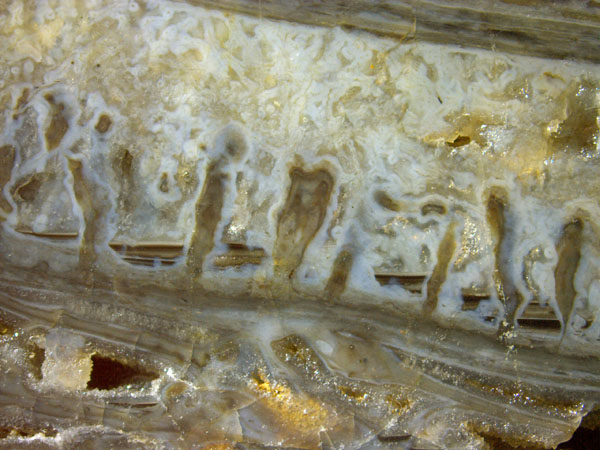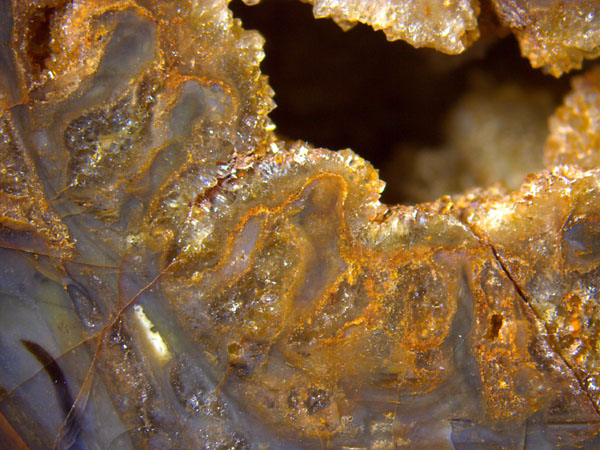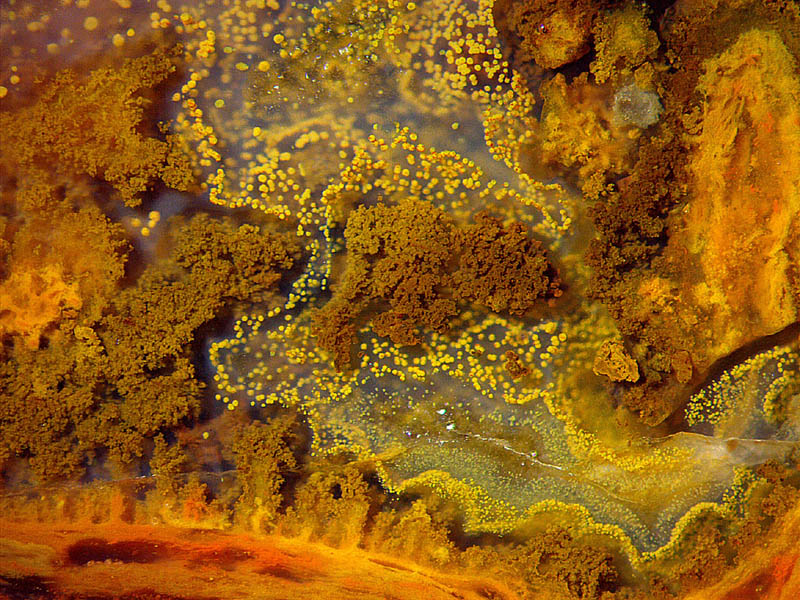Microbial emergences in
Devonian and Permian cherts

Silicified
microbes in chert are often seen as more or less stratified dark
layers extending nearly horizontally, as in
Fig.1 above and below. Also they may be found arranged as brightly
coloured laminated
stacks in transparent chert
or on layered boulders known as stromatolites, for example. Bizarre
shapes emerging from the strata are conspicuous exceptions (Fig.1).
(See also Rhynie Chert News 67).
Fig.1:
Rhynie chert with slightly inclined microbial layers extending far
beyond the picture frame, beset with emergences; later formed levels of
watery suspensions in between.
Width 17mm.
The level stacks between the emergences indicate the
horizontal direction during silicification. They also indicate that
not all water turned into silica gel at once. First, a thin coating of
silica gel, now seen as bluish chalzedony, had covered every dark
aggregation of microbes. Fluid silica suspensions,
stained black possibly by dead microbes, accumulated in water
pockets left in between, where
they now appear as litte "ponds". Water pockets still remaining
after subsequent silicification got a lining of glittering
quartz crystals.

Fig.2 (left): Rhynie
chert with tilted microbial layer beset with emergences separated
from later grown quartz crystals by a thin yellow boundary. Width 11mm.
A bigger water pocket left after silicification and
more glittering quartz is seen in Fig.2. The microbial layer bearing
the emergences is much
tilted there. (The horizontal direction is indicated by the small level
layer
in the corner below right.) Instead of a light-coloured coating around
the emergences as in Fig.1, the ones in Fig.2 are distinguished by a
thin
mineral cover seen as a rugged yellow line on this cut face. The
quartz crystals instead of chalzedony between the
emergences indicate slower silicification than in Fig.1.
Fig.3 (below): Permian chert consisting of clear
chalzedony with microbial
formations and mineral precipitates
(from the "Maggot stone" site, Haenichen, Saxony, Germany.)
Width 3.5mm.

Part
of what is seen here can be understood by starting interpretation at
the
bottom of this image.
There is a laminated stack of microbial layers, probably thin
sheets of some blue-green alga, damaged with holes. Apparently
not affected by the damage below, emergences are seen standing
perpendicular to the layer surface.
The question arises why the microbes occasionally
change their mode of aggregation from flat sheets to emergences arising
from them. Similar phenomena are well known from myxobacteria and
slime moulds.
Although
some questions must remain without an answer here, the succession of
events which brought about the confusing structure in Fig.3 can
roughly be reconstructed:
First came the stack of thin
microbial sheets grown in water, now stained yellow and red
owing to later precipitation of iron oxides. Emergences of various
shapes are seen arising from the uppermost sheet.
They seem to have contributed to the formation of brown granular
aggregates and clear silica gel enclosing
them. The large water-filled cavities still left between the gel were
free for another round of silicification which produced the clouds of
bright yellow dots. Later, tiny glittering quartz crystals, faintly
visible now, grew slowly
in two remaining water pockets amidst the yellow clouds.
The enigmatic holes must have been eaten into the
stack of sheets while it was not yet silicified. An alternative idea of
a creature simply squeezing
through the stack would imply deformations of the sheets but there are
none. This is one of a few more examples of creature effects seen in
cherts without the creature showing up.
Finally, the holes like everything else, except the quartz
crystals, had turned into solid chalzedony.
Samples:
Fig.1: Rh15/63, (0.62kg, obtained from Barron in
2012, here Part1); Fig.2:
Rh10/8 (0.45kg, found in 2004, here Part2); Fig.3:
H/293 (1.52kg, found in 2000 at Hänichen, Saxony, cut into 6
parts, here Part5;
H.-J.
Weiss
2019
 |
 |
146 |






